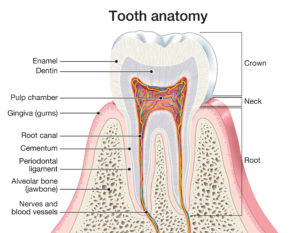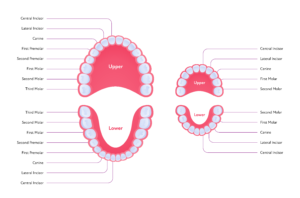Have you ever stopped to really look at your teeth? Beyond using them to bite and chew your food, they are on display every time you smile, or laugh or speak. Having good healthy teeth is important for several reasons, including having a positive impact on your self-esteem.
There is a lot of research on how smiling boosts your confidence, and makes you feel happy, confident and in control. When you smile you get an emotional response, your brain and body work together and release chemicals such as dopamine which affects your moods. We use three types of smiles, spontaneous for when something makes us feel amused, social smiles for when we interact with people and emotional smiles for when we feel happy or sad. Having a great smile can help you to cope in any situation, even an interview for a job, apprenticeship or university.
Great smiles need strong healthy teeth and gums and in this article, we will look at the life cycle of teeth, the components of a tooth and suggest top tips on how to keep your teeth and gums healthy so you can make the most of your smile!
So do you know what the tooth is made up of?
First of all, you need to know that the tooth has two sections: the crown and the root. The crown is the top of the tooth that is usually white and anything that is above the gums. The root of the tooth is anything that is below the gum line and is not exposed. The crown contains mainly dentin and enamel whereas the root contains cementum and most of the pulp. The crown joins the root by a slight change in the structure of the tooth which is known as the neck.
Teeth consist of 4 major tissues: pulp, dentin, cementum and, the most known tissue, enamel. Enamel, dentin, and cementum are all hard tissues which means that they are mineralised tissues that possess a high degree of hardness. Pulp tissue is soft and non-calcified. It is made up of groups of cells that connect to each other to support surrounding structures (such as the 3 hard tissues) in the mouth.

Illustration showing the anatomy of a tooth
Image: Illustration showing anatomy of a tooth
Enamel is made of hard, white, calcified material which surrounds the crown of the tooth. It acts as the first defence as a protective barrier against plaque and acids, if not removed it can harden into tartar. It also protects the tooth from the impact of biting, chewing, and grinding which sometimes causes enamel to wear. Salivary glands in the mouth work to neutralise any acids that come from the food that we eat but too much exposure can cause the enamel to erode which results in the teeth turning yellow after time. Therefore, it is extremely important to regulate the food that we eat to ensure that our enamel stays intact.
Cementum is connective tissue, which is slightly softer than enamel, it anchors the root of the tooth to the jawbone by helping the periodontal ligament attach firmly to the tooth. Cementum also covers the tooth’s dentin so if the tooth is affected by loss of cementum, dentin is exposed which can lead to tooth sensitivity. If the periodontal ligament becomes irreversibly damaged, cementum is lost causing the tooth to loosen or shift. For that reason, we should keep up with our daily brushing requirements to keep our teeth and gums healthy and prevent gum disease.
Dentin is the layer under the enamel which makes up the majority of the tooth and because dentin is deep yellow/brown in nature when the enamel is worn, dentin becomes exposed and the teeth are yellow. Dentin reinforces the enamel by making it harder in addition to safeguarding the softer sensitive pulp tissue which makes up the inside of the tooth. The tissue contains microscopic tubules which carry any fluid and nutrients that your dentin needs from the pulp chamber to the dentin to nourish it. When the enamel is worn, heat, cold or acidic foods can enter the tooth through these tubules and cause sensitivity and pain. To prevent this, oral health must be maintained to a high standard so that the teeth remain strong, healthy and white. Therefore, the dentin layer is extremely important because it protects the tooth from decay and cavities.
Finally, the pulp is a soft, living tissue found within the pulp chamber containing blood vessels, connective tissue and nerves. The pulp provides teeth with nourishment through the formation and nutrition of the dentin layer which protects the tooth from decay and cavities. If the pulp chamber is compromised, various issues can occur but a common condition is pulpitis. Pulpitis is a painful inflammation of the pulp due to the invasion of bacteria which causes it to swell. On that account, it is vital to keep your pulp chamber healthy by brushing twice a day, using dental floss or interdental brushes regularly after meals.
But have you ever wondered how teeth develop?
Everyone is aware that teeth grow when you are a young child, fall out and grow again but there are processes that begin way before your first baby or primary tooth breaks the gum line. A normal adult has 32 secondary or permanent teeth in total:
- 8 Incisors – 4 front bottom teeth and 4 front top teeth.
- 4 Canines – sharpest teeth, 2 either side of upper and lower teeth.
- 8 Premolars – permanent teeth located between the molars.
- 8 Molars – large flat teeth at the back of the mouth.
- 4 Wisdom teeth – a 3rd set of molars that grow during early twenties and are usually removed. Not everyone gets visible Wisdom teeth.

Image: Dental jaw and tooth anatomy chart.
Teeth begin to develop in the embryonic stage at about 3-6 weeks where soft tissue begins to form. At 3-4 months, hard tissue forms around the tooth and thin translucent roots begin to grow downwards. By the time of birth, there are 20 fully developed teeth below the gum line ready to erupt at 3-6 months during a stage known as teething. The first primary teeth to erupt are the incisors followed by the upper and lower molars. The canines are the last to erupt at 16-23 months.
The process of primary teeth falling out is known as normal resorption of teeth. When the primary teeth are ready to fall out, specialised cells deteriorate the tooth root while the permanent secondary teeth push them up and out. Baby teeth typically fall out in the order that they erupted in but adult teeth tend to erupt randomly. All permanent teeth have normally erupted by the age of 12 and are often in need of straightening through orthodontic treatment. Once permanent teeth have come in, they aren’t supposed to fall out, however, tooth loss can occur. This can be due to a lack of oral hygiene, which causes tooth decay, cavities, gingivitis and periodontitis. Less common causes for tooth loss include illness (such as diabetes), accidents and injury.
There are various roles within the field of Dentistry that work on different issues associated with teeth
- General dentist – prevent and treat dental/oral disease, correct dental irregularities, and treat dental/facial injuries.
- Orthodontist – a person that corrects mal-positioning of teeth and jaw alignment.
- Dental assistant – Provides hands-on help for the dental practitioner. Sterilises equipment, prepares X-rays and takes impressions of teeth.
- Dental hygienists – perform dental cleanings, examine patients for signs of oral diseases and educate patients on ways to improve oral health.
- Dental technicians – manufacture dental prosthetics such as bridges, crowns, and dentures.
- Periodontist – specialised dentist who prevents, diagnoses, and treats periodontal disease.
- Oral surgeon – performs medical procedures related to the mouth, jaw and/or gums.
Top tips to protect your smile!
Everyone thinks they know what to do to look after their teeth and gums but what most people don’t realise is how your teeth and your smile physically and emotionally affect you. It is crucial to keep up with healthy brushing habits, maintain a balanced diet and visit your dentist for regular check-ups.
- Brush twice a day for 2-3 minutes
- Use fluoride toothpaste and mouthwash
- Use dental floss or interdental brushes between meals and before you brush them
- Avoid acidic and sugary food or drinks
- Spit out toothpaste, don’t rinse!
- See your dentist at least twice a year
These top tips will help you to keep your teeth and gums in excellent shape and preserve that beautiful healthy white smile.
Download PDF
If you wish to save, or print, this article please use this pdf version »

